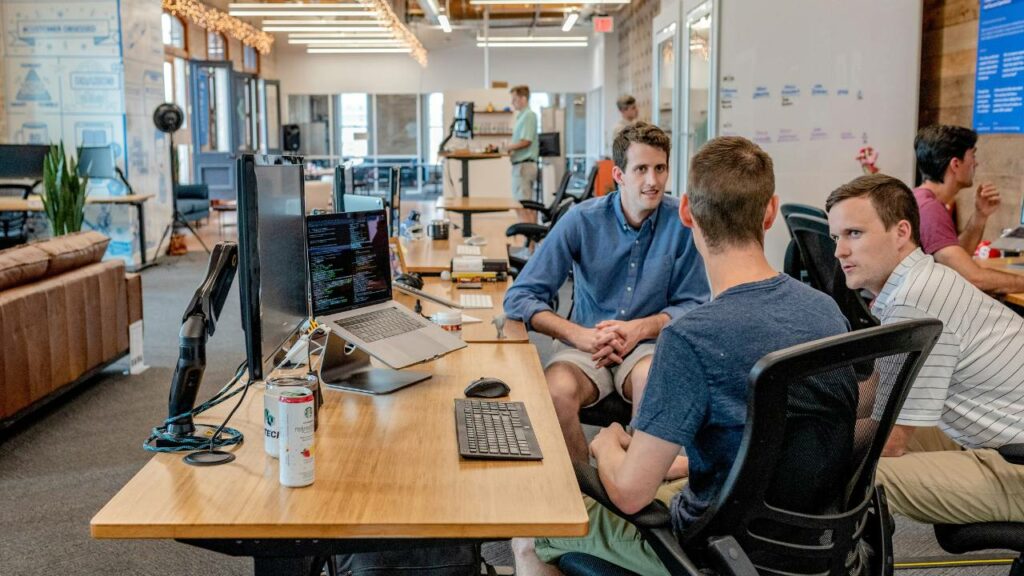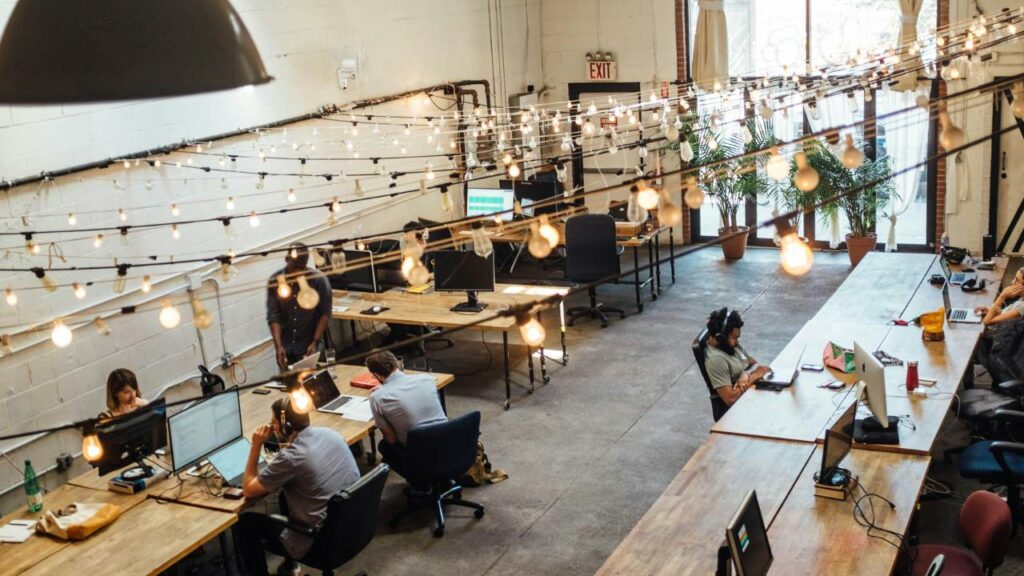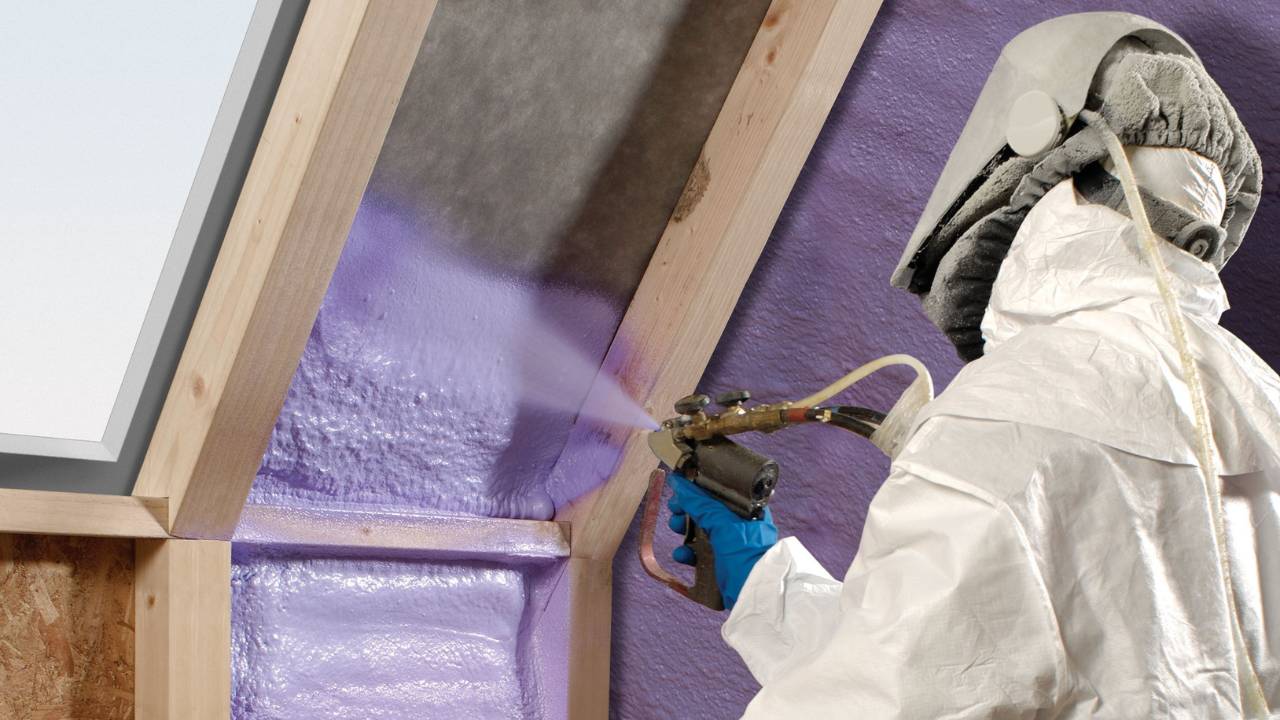Imagine walking into an office where the physical barriers between you and your colleagues are reduced, where you can see everyone working diligently, occasionally pausing to share an idea or offer assistance. This is the essence of an open workspace, a design concept that has transformed contemporary offices across diverse industries. By embracing the lack of interior walls and private rooms, businesses are fostering an environment that champions effortless communication and cooperation.
Your personal productivity can greatly benefit from the interactive nature of open workspaces. The ease of turning to a mate for a quick question or gathering a spontaneous team for brainstorming sessions cannot be understated. It’s this seamless flow of ideas and information that propels projects forward and clarifies complex issues without the need for formal meetings. The open-plan layout bridges the gap between different levels of the corporate hierarchy, promoting a democratic space that encourages input from all members of your team.
However, while they enhance collaboration, open workspaces also present unique challenges. Distractions are more common in such vibrant environments, and the lack of privacy can be a concern for some. Thus, finding a balance between open areas for teamwork and quiet zones for focused work is crucial in crafting an effective open workspace. Your ability to adapt to an open-plan office could very well be the catalyst that not only elevates your performance but also contributes to a more unified and successful company culture.
Exploring Open Workspaces
Open workspaces, similar to the concept of an open-plan kitchen in your home, allows for a fluid, flexible environment aimed at boosting collaboration and innovation among teams. However, it’s important to account for potential challenges such as noise and distraction.
Benefits of Open Office Layout
Your experience in open office spaces will often be filled with opportunities for spontaneous collaboration and a greater sense of transparency. One of the key advantages you’ll notice is increased accessibility to colleagues, fostering an environment where ideas and creativity can flourish. With fewer physical barriers, your ability to connect with teammates is enhanced, potentially accelerating problem-solving processes and leading to a surge in innovation.
On top of that, the reduction in setup costs can’t be ignored. By doing away with the need for individual offices or cubicles, your company can save on furniture and construction expenses. This financial saving can then be diverted into other growth-driving aspects of the business.
Challenges and Solutions
While the openness facilitates communication, it can also bring about increased levels of noise and distraction, which can sometimes escalate stress. To combat this, sound-absorbing materials like acoustic panels can be incorporated into your workspace design to mitigate noise levels. Additionally, establishing “quiet zones” can provide you with spaces for focused work when needed.
The impact of office colour schemes should also be considered, as subtle shades can help create a calming environment. Distraction management becomes another significant area for focus. Employing visual signals, like a coloured flag or a light system, can alert colleagues to your need for concentration, reducing interruptions.
To further alleviate stress, ensuring that you have access to private areas for confidential conversations or contemplation can maintain a sense of personal space and mental well-being in an otherwise open setting.
Impact on Communication and Collaboration

Open workspaces are designed to bring down walls, both literally and metaphorically, to improve the way you communicate and collaborate. By strategically removing physical barriers, the environment encourages more frequent and free-flowing conversations, making your team more dynamic and responsive to the demands of collaborative projects.
Facilitating Teamwork
In an open workspace, the layout means you’re more likely to engage in spontaneous meetings and discussions. The ease of access to your colleagues supports the flow of information, helping you to stay in the loop and quickly get answers to questions or immediate feedback. Sharing a common space fosters a sense of camaraderie and shared purpose, which is essential for the trust and close coordination required in teamwork.
Enhancing Engagement and Connection
The open-plan design promotes regular interaction and fosters a sense of community among employees. You may find that the informal setting enhances connection with your colleagues, making it easier to establish strong, trusting relationships. Regular face-to-face interactions tend to lead to higher engagement in projects, as you feel more connected to both the team’s goals and the individuals working beside you. This close proximity also tends to promote increased transparency in communication, often resulting in improved alignment and understanding across different project teams.
Design and Management of Open Spaces

In your approach to open workspaces, it’s essential to harmonise technology with office design and apply effective management strategies.
Integrating Technology and Office Design
Your office design should embrace technology seamlessly. Consider embedding sensors in strategic locations to track usage patterns and adjust the environment for optimal comfort and energy efficiency. This data can lead to a more flexible use of space, allowing you to cater for different working styles and needs with agility.
Management Strategies for Open Workspaces
Effective management of open workspaces can significantly boost your team’s productivity. One key aspect is to ensure clear communication of the spaces’ intended use. This reduces confusion and ensures a harmonious work environment.
Establish rules to respect others’ space, such as designated quiet zones or ‘no interruption’ signals, which helps maintain a respectful and productive atmosphere. Additionally, offering booking systems for meeting rooms or hot desks allows for better scheduling and space utilisation.
Training your management team to recognize when adaptations are necessary is crucial. They should also foster a culture of feedback, where your team feels comfortable sharing their experiences of the workspace, ensuring ongoing improvement and adaptation to changing needs.
The Evolution of Privacy and Boundaries
In the dynamic landscape of business workspaces, your need for privacy has shaped the design of offices over time, often finding a middle ground between openness and seclusion.
Balancing Openness with Privacy
The shift towards open workspaces was motivated by the desire to foster collaboration and communication among you and your colleagues. Initially, the switch from private offices to open plans marked a significant change in how you experience the workplace. You’ve seen the rise of cubicles, a sort of hybrid that offers a semblance of privacy while still maintaining the open-plan ethos. The challenge remains: ensuring that you have sufficient privacy to concentrate and feel comfortable, without stifling the ease of interaction that open spaces promote.
Spatial Boundaries and Personal Space
Recognising your need for personal space has led to the incorporation of spatial boundaries within the open office layout. These are often subtle cues such as varying floor materials, changes in lighting, or semi-transparent partitions, which suggest divisions without erecting walls. Although not as isolating as private offices, these spatial boundaries allow you to feel a sense of individual territory. Furniture placement and office decor are intentionally selected to create these gentle divisions, helping you understand where your space starts and ends without compromising the openness of the environment.
Adapting to the Future of Work

With the evolution of workspaces, you are expected to keep apace with changes, such as the rise in remote work. Understanding how to merge traditional office environments with today’s technological possibilities is crucial. As shared office space becomes a norm, you’re faced with opportunities and challenges to maintain both your health and professional effectiveness.
Engagement in remote work provides you with the flexibility to manage your tasks away from a centralised office. This change requires strong self-discipline and can sometimes lead to feeling socially withdrawn. Investment in suitable technology and communication tools is essential to ensure that you remain integrated with your team.
It’s a natural human response to seek interaction; thus, creating a blend of remote and office-based work can help. You might consider a shared office setup, facilitating both social interaction and independent work. These spaces boost creativity, provide a change of scene, and offer opportunities for networking.
Maintaining your health in the new work environment is critical. Prioritising ergonomics at your personal workspace – be it at home or in a shared office – helps prevent physical strain. Remember to take regular breaks, practice exercises, and maintain a work-life balance, which are all vital for long-term wellbeing.
Adapting is not just about the physical space; it’s an ongoing process of personal and professional growth. Stay proactive and embrace flexible working practices to thrive in the changing landscape of work.
Conclusion
Exploring open workspaces is a journey towards enhanced collaboration and transparency.
An open design fosters effortless engagement, contributing to flexible working conditions and fluid team dynamics. Despite challenges like noise, creative layouts and quiet areas can offer solutions.
Witness potential productivity boosts as barriers between team members diminish, motivating individuals and fostering a dynamic atmosphere. Striking a balance between collaboration and individuality is key, creating a vibrant workplace culture that aligns with your business objectives.
In summary, transforming your workspace with style by going with an open office ethos paves the way for a connected and harmonious workplace, enhancing cohesiveness while respecting the need for personal space.


